 We’ll get to the Camas in a bit, but that was a surprise find, not what I went looking for today.
We’ll get to the Camas in a bit, but that was a surprise find, not what I went looking for today.
Last weekend when I was down to the Columbia Gorge searching for Garrya I spent a few minutes at Catherine Creek to check out the earliest flowers, including Grass Widows, Olsynium douglasii. Today Natalie and I headed down to Pass Island at Deception Pass State Park in search of the same flower. Pass Island is one of the earliest spots in our region where the flowers start blooming. It has thin, rocky soil similar to what you find at Catherine Creek and the open slopes face south and west where they can bake in the afternoon sun.
Based on the number of Grass Widows in bloom today I’d say our season is nearly a month advanced from last year. Of course, last year was a cold winter and everything was late. This has been a warm winter. I guess it all works out in the averages over a century.
In any case there were lots of Grass Widows in bloom. They aren’t really visible from the bridge but as soon as we stepped out from under it on the island the bright magenta flowers came into sight at the expected spots.
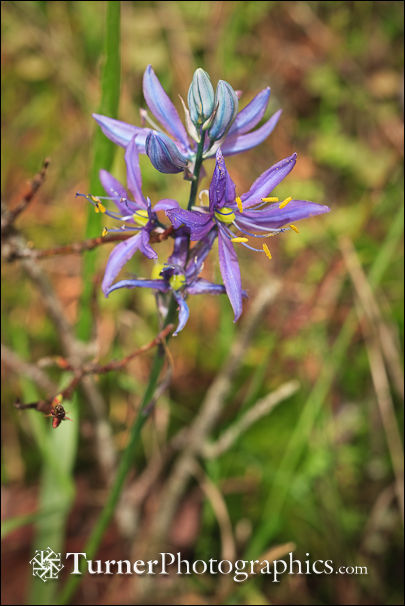 We continued walking along the path toward the east end of the island, checking out whatever we could find in bloom. There were many bright splotches of yellow Spring Gold, Lomatium utriculatum with its broad umbels nestled among finely divided bright green foliage. There were tall stalks of Western Saxifrage, Saxifraga occidentalis, foliage of Western Buttercups, a single blossom of Beach Strawberry, swelling buds on the Madronas, and new leaves emerging everywhere. Broadleaf Stonecrop, Sedum spathulifolium, rosettes of foliage carpeted many rock faces and masses of Licorice Fern waved gently in the warm breeze.
We continued walking along the path toward the east end of the island, checking out whatever we could find in bloom. There were many bright splotches of yellow Spring Gold, Lomatium utriculatum with its broad umbels nestled among finely divided bright green foliage. There were tall stalks of Western Saxifrage, Saxifraga occidentalis, foliage of Western Buttercups, a single blossom of Beach Strawberry, swelling buds on the Madronas, and new leaves emerging everywhere. Broadleaf Stonecrop, Sedum spathulifolium, rosettes of foliage carpeted many rock faces and masses of Licorice Fern waved gently in the warm breeze.
But the real find was this precocious single stem of Common Camas, Camassia quamash, growing at the side of the trail in a protected spot at the edge of the woods. We hardly saw any other Camas with buds; most of the foliage was still pretty short. I can’t recall ever seeing Camas in bloom this early. Usually it comes out after the Grass Widows are finished. This specimen wasn’t in the most photogenic location as it was coming up through the dormant stems of a shrub I didn’t bother to identify. I cleaned out the dry grass stems, but the shrub had to stay. But it’s the first of the season!
 When you visit the same place over a period of years you get familiar with where to look for certain plants. This Red-flowering Currant on the cliff just above high tide has been there for years and is always one of the first to bloom. There’s no way to get close to it and enjoy the fragrance of the blossoms, but I’m sure the bees and possibly the hummingbirds find it just fine. I made this image with my 70-200mm lens zoomed most of the way in. The sun was playing in and out of the clouds and I shot it both ways. This is the sunny version, which I like a bit better because it brings out the color of the blossoms better.
When you visit the same place over a period of years you get familiar with where to look for certain plants. This Red-flowering Currant on the cliff just above high tide has been there for years and is always one of the first to bloom. There’s no way to get close to it and enjoy the fragrance of the blossoms, but I’m sure the bees and possibly the hummingbirds find it just fine. I made this image with my 70-200mm lens zoomed most of the way in. The sun was playing in and out of the clouds and I shot it both ways. This is the sunny version, which I like a bit better because it brings out the color of the blossoms better.
The rest of today’s photos were made with my 100mm macro lens. I used a collapsible diffuser when the sun was out and the natural clouds when it wasn’t. As usual my camera was on the tripod for everything.
Natalie pointed out foliage along the trail that I think may be the first leaves of Chocolate Lilies, Fritillaria affinis. They certainly grow in the area, but I haven’t seen them blooming on Pass Island so I’ll have to check back later in the season and see what the foliage turns out to be.
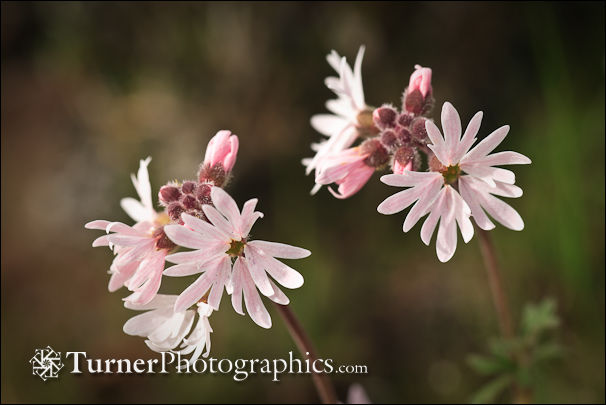
The other flower we saw in several locations on Pass Island was Small-flowered Prairie Star, Lithophragma parviflorum. The name is a bit of a misnomer because the flowers are actually bigger than those of the other common species in the northwest, Bulbiferous Woodland Star.
After we’d seen all we could find in bloom on the island we headed to West Beach and walked along the dunes trail. Not much was blooming there except the Spring Whitlow Grass, Draba verna and an occasional blossom on Beach Knotweed, Polygonum paronychia. It will be several weeks before there’s much blooming in that part of the park.
I’ll be leading a field trip to Pass Island for the Koma Kulshan chapter of the Washington Native Plant Society on Saturday, March 20. I’ve already had some people sign up, so let me know if you’d like to come along and enjoy these flowers and more in person.
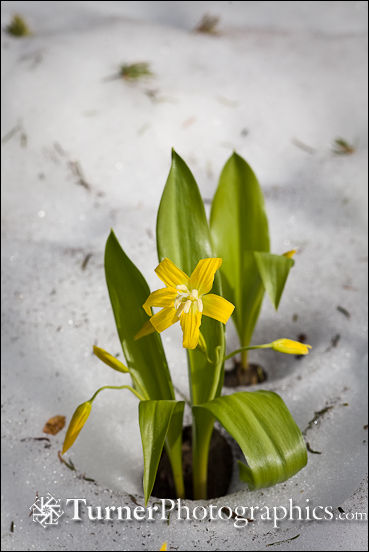 This month we’ll explore a whole genus of plants rather than single species. They’re the Erythroniums and there are species that grow in a wide range of habitats all across the country. I first learned them as Dog-tooth Violets in the mid-Atlantic forests. Various members of the genus are also called Trout Lily, Adder’s Tongue, Fawn Lily, Glacier Lily, or Avalanche Lily. No matter what you call them they are members of the Lily family. Continue reading
This month we’ll explore a whole genus of plants rather than single species. They’re the Erythroniums and there are species that grow in a wide range of habitats all across the country. I first learned them as Dog-tooth Violets in the mid-Atlantic forests. Various members of the genus are also called Trout Lily, Adder’s Tongue, Fawn Lily, Glacier Lily, or Avalanche Lily. No matter what you call them they are members of the Lily family. Continue reading 

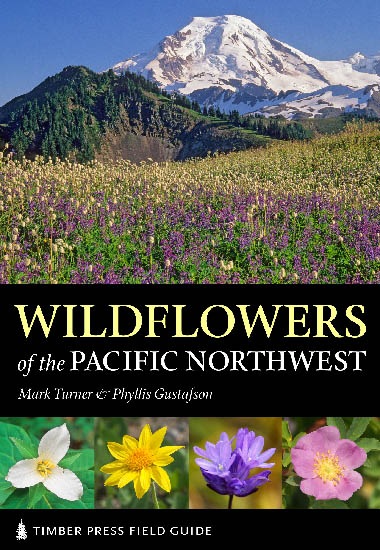 Wildflowers of the Pacific Northwest, which came out in 2006, continues to sell well. Its in at least its 5th printing and has sold over 17,500 copies as of December 31, 2009. If you don’t have a copy yet, or want to give one as a gift, you can order autographed copies from me online at
Wildflowers of the Pacific Northwest, which came out in 2006, continues to sell well. Its in at least its 5th printing and has sold over 17,500 copies as of December 31, 2009. If you don’t have a copy yet, or want to give one as a gift, you can order autographed copies from me online at 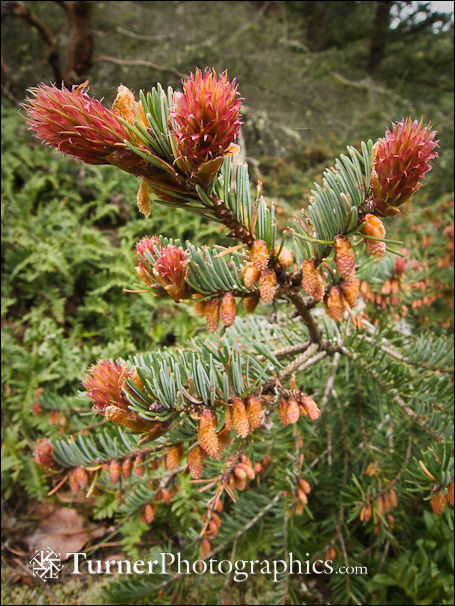 Sex was in the air all over Pass Island and West Beach at Deception Pass State Park this weekend. Bright red female Douglas-fir cones standing tall on branch tips were calling out to the pollen-laden male cones hanging below. “Hit me with some of your dusty golden pollen,” they seemed to be saying. And with every stiff branch-shaking breeze (or human hand) the air would blaze with the pixie dust so essential to the Pseudotsuga menziesii mating ritual.
Sex was in the air all over Pass Island and West Beach at Deception Pass State Park this weekend. Bright red female Douglas-fir cones standing tall on branch tips were calling out to the pollen-laden male cones hanging below. “Hit me with some of your dusty golden pollen,” they seemed to be saying. And with every stiff branch-shaking breeze (or human hand) the air would blaze with the pixie dust so essential to the Pseudotsuga menziesii mating ritual. We’ll get to the Camas in a bit, but that was a surprise find, not what I went looking for today.
We’ll get to the Camas in a bit, but that was a surprise find, not what I went looking for today. We continued walking along the path toward the east end of the island, checking out whatever we could find in bloom. There were many bright splotches of yellow Spring Gold, Lomatium utriculatum with its broad umbels nestled among finely divided bright green foliage. There were tall stalks of Western Saxifrage, Saxifraga occidentalis, foliage of Western Buttercups, a single blossom of Beach Strawberry, swelling buds on the Madronas, and new leaves emerging everywhere. Broadleaf Stonecrop, Sedum spathulifolium, rosettes of foliage carpeted many rock faces and masses of Licorice Fern waved gently in the warm breeze.
We continued walking along the path toward the east end of the island, checking out whatever we could find in bloom. There were many bright splotches of yellow Spring Gold, Lomatium utriculatum with its broad umbels nestled among finely divided bright green foliage. There were tall stalks of Western Saxifrage, Saxifraga occidentalis, foliage of Western Buttercups, a single blossom of Beach Strawberry, swelling buds on the Madronas, and new leaves emerging everywhere. Broadleaf Stonecrop, Sedum spathulifolium, rosettes of foliage carpeted many rock faces and masses of Licorice Fern waved gently in the warm breeze. When you visit the same place over a period of years you get familiar with where to look for certain plants. This Red-flowering Currant on the cliff just above high tide has been there for years and is always one of the first to bloom. There’s no way to get close to it and enjoy the fragrance of the blossoms, but I’m sure the bees and possibly the hummingbirds find it just fine. I made this image with my 70-200mm lens zoomed most of the way in. The sun was playing in and out of the clouds and I shot it both ways. This is the sunny version, which I like a bit better because it brings out the color of the blossoms better.
When you visit the same place over a period of years you get familiar with where to look for certain plants. This Red-flowering Currant on the cliff just above high tide has been there for years and is always one of the first to bloom. There’s no way to get close to it and enjoy the fragrance of the blossoms, but I’m sure the bees and possibly the hummingbirds find it just fine. I made this image with my 70-200mm lens zoomed most of the way in. The sun was playing in and out of the clouds and I shot it both ways. This is the sunny version, which I like a bit better because it brings out the color of the blossoms better.
 There aren’t a lot of native shrubs that bloom in the winter. One that does is Fremont’s Silk Tassel, also known as Bearbrush, Garrya fremontii. This species has the northernmost range of any of the
There aren’t a lot of native shrubs that bloom in the winter. One that does is Fremont’s Silk Tassel, also known as Bearbrush, Garrya fremontii. This species has the northernmost range of any of the 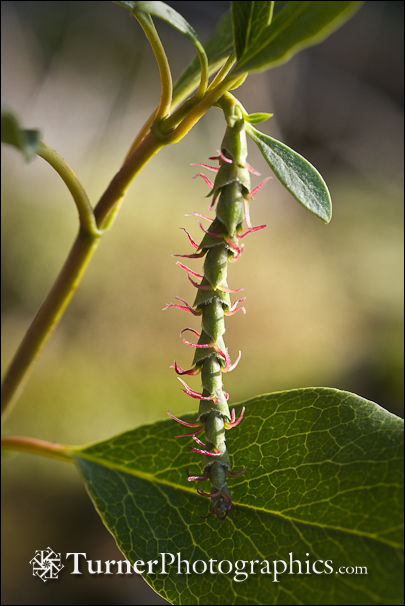 This specimen was a female, with its red pistals sticking out all around the dangling tassel that gives the plants its name. I looked around some more but didn’t find any other specimens nearby. It was growing adjacent to a Vine Maple and near Douglas-firs, all somewhat stunted on this loose south-facing talus.
This specimen was a female, with its red pistals sticking out all around the dangling tassel that gives the plants its name. I looked around some more but didn’t find any other specimens nearby. It was growing adjacent to a Vine Maple and near Douglas-firs, all somewhat stunted on this loose south-facing talus. Here’s the male Bearbrush Silktassel catkin. I found this specimen at the top of a road cut near the junction of Willard Road and Cook-Underwood Road. I was on my way to Willard and beyond where another herbarium specimen had been collected. This plant was at about 1000′ elevation and the male flowers had not yet completely opened. I believe that when they’re fully open the stamens will be showing. I made lots of images of the male plant and then continued up the road.
Here’s the male Bearbrush Silktassel catkin. I found this specimen at the top of a road cut near the junction of Willard Road and Cook-Underwood Road. I was on my way to Willard and beyond where another herbarium specimen had been collected. This plant was at about 1000′ elevation and the male flowers had not yet completely opened. I believe that when they’re fully open the stamens will be showing. I made lots of images of the male plant and then continued up the road.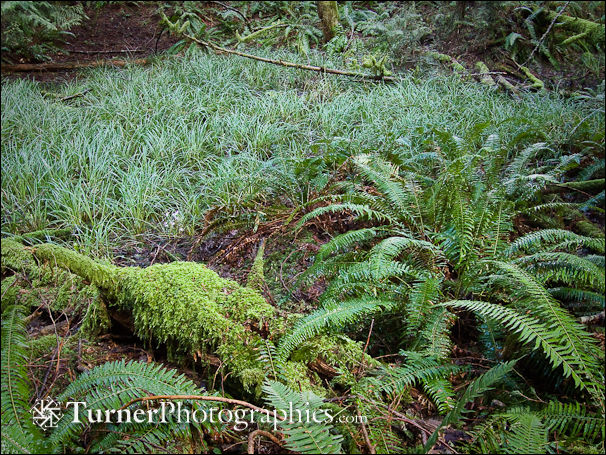
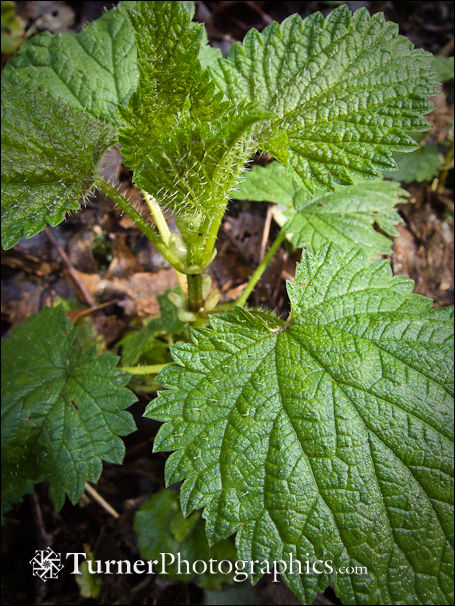 One plant that had started to grow is Stinging Nettle, Urtica dioica. When they get just a little bigger it will be time to harvest some (but not from the Stimpson Preserve) and cook them up for a tasty spring vegetable. Some folks say you can eat them raw if you curl the leaves just right to avoid the little spines that inject a chemical soup that gives the plant its name, but I’ve never been successful at it. For details on the chemicals in nettle sting see
One plant that had started to grow is Stinging Nettle, Urtica dioica. When they get just a little bigger it will be time to harvest some (but not from the Stimpson Preserve) and cook them up for a tasty spring vegetable. Some folks say you can eat them raw if you curl the leaves just right to avoid the little spines that inject a chemical soup that gives the plant its name, but I’ve never been successful at it. For details on the chemicals in nettle sting see 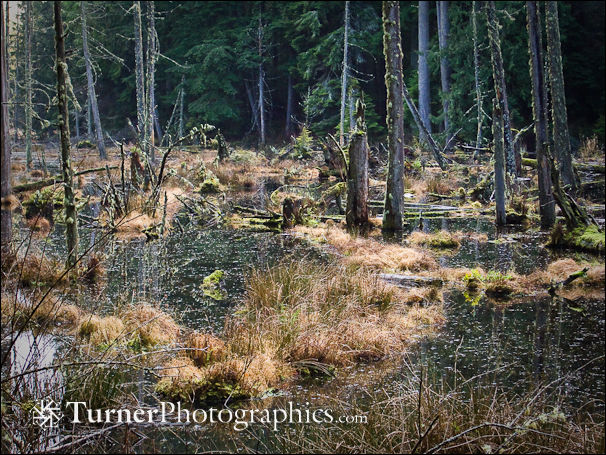
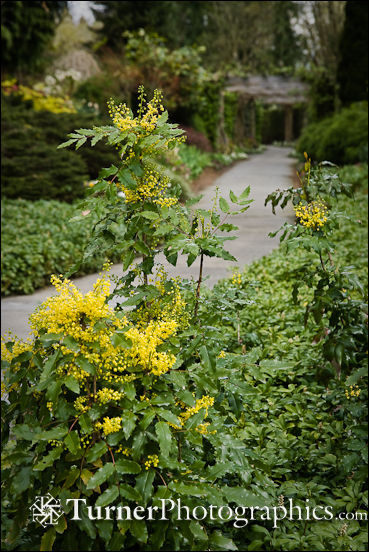 One of the first of our northwest native shrubs to bloom is Tall Oregon Grape, Mahonia aquifolium. It also goes by the name Shining Oregon Grape because its foliage is a bright glossy green.
One of the first of our northwest native shrubs to bloom is Tall Oregon Grape, Mahonia aquifolium. It also goes by the name Shining Oregon Grape because its foliage is a bright glossy green. 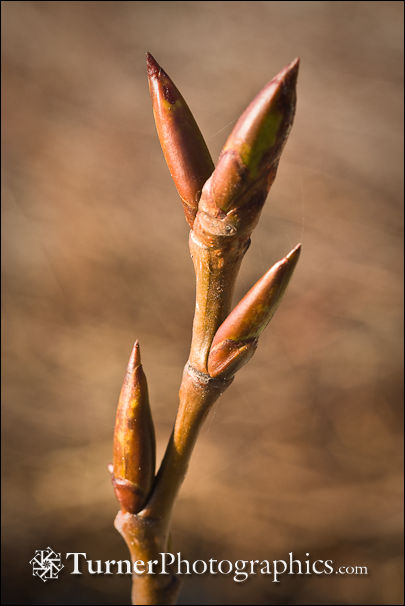 On our walk to Little Squalicum Beach last weekend Natalie and I looked at more than just the willow buds I included in the
On our walk to Little Squalicum Beach last weekend Natalie and I looked at more than just the willow buds I included in the 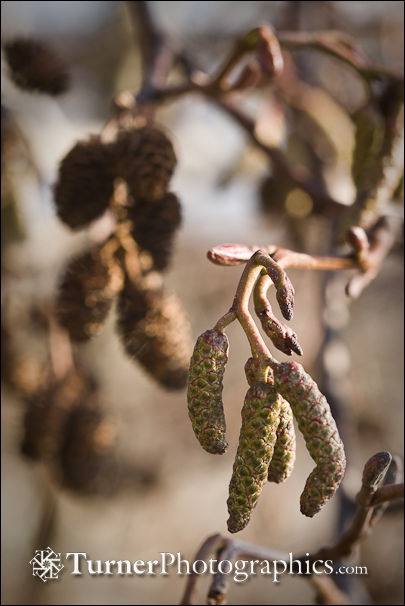 Perhaps the most common deciduous tree in our lowland forests is Red Alder, Alnus rubra. It establishes quickly on disturbed sites and is an important species because it is a nitrogen fixer. That is, it takes nitrogen from the air and with the cooperation of symbiotic fungi on its roots, adds it to the soil in a form other plants can use.
Perhaps the most common deciduous tree in our lowland forests is Red Alder, Alnus rubra. It establishes quickly on disturbed sites and is an important species because it is a nitrogen fixer. That is, it takes nitrogen from the air and with the cooperation of symbiotic fungi on its roots, adds it to the soil in a form other plants can use. The Pacific Northwest is home to many species of willow. Some are shrubby, some grow to be fairly substantial trees, and some can be either a shrub or a tree depending on where they’re growing.
The Pacific Northwest is home to many species of willow. Some are shrubby, some grow to be fairly substantial trees, and some can be either a shrub or a tree depending on where they’re growing.